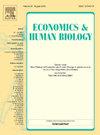Expanded prescription coverage and opioid use disorders: Evidence from Medicare Part D
IF 1.8
3区 医学
Q2 ECONOMICS
引用次数: 0
Abstract
Medicare Part D, implemented on January 2006, expanded subsidized outpatient prescription-drug coverage, including medication-assisted treatment (MAT) drugs, for adults aged 65 and older. Using 6.2 million discharge records from the 2001 to 2011 Healthcare Cost and Utilization Project National Inpatient Sample, I study how this policy influenced serious opioid use disorder (OUD) events. The analysis uses a difference-in-differences framework that compares OUD-related hospitalizations among 65- to 69-year-olds with those of 60- to 64-year-olds, and an event study confirms parallel trends before implementation. Part D lowered OUD-related hospital admissions by 158.3 per 100,000 discharges, a 53% decline from the pre-policy mean. The reduction is concentrated in admissions that include diagnoses of opioid abuse or dependence, whereas admissions related to opioid poisoning show little change. Larger proportional declines among Black and Hispanic adults and among men indicate that changes in drug coverage were accompanied by differences in outcomes across demographic groups. Estimates are robust across alternative specifications. By reducing out-of-pocket costs for MAT drugs covered by Part D, comprehensive prescription benefits can substantially cut avoidable hospital stays even when individual treatment uptake is not observed. These findings inform current debates on drug-benefit design for aging populations confronting opioid-related harm and illustrate how insurance coverage shapes health production later in life.
扩大处方覆盖范围和阿片类药物使用障碍:来自医疗保险D部分的证据
2006年1月实施的医疗保险D部分扩大了65岁及以上成年人的门诊处方药补贴覆盖范围,包括药物辅助治疗(MAT)药物。利用2001 - 2011年医疗成本与利用项目全国住院患者样本的620万份出院记录,研究该政策如何影响严重阿片类药物使用障碍(OUD)事件。该分析使用了差异中的差异框架,比较了65至69岁人群与60至64岁人群中与oud相关的住院情况,一项事件研究证实了实施前的平行趋势。D部分将与疾病相关的住院率降低了158.3 / 10万,比政策出台前的平均值下降了53%。减少主要集中在包括阿片类药物滥用或依赖诊断的入院人数上,而与阿片类药物中毒有关的入院人数几乎没有变化。在黑人和西班牙裔成年人以及男性中,比例较大的下降表明,药物覆盖率的变化伴随着不同人口群体的结果差异。评估在可选规范中是健壮的。通过减少D部分涵盖的MAT药物的自付费用,即使在没有观察到个人治疗的情况下,综合处方福利也可以大大减少可避免的住院时间。这些发现为当前针对面临阿片类药物相关危害的老年人口的药物效益设计提供了信息,并说明了保险范围如何影响生命后期的健康生产。
本文章由计算机程序翻译,如有差异,请以英文原文为准。
求助全文
约1分钟内获得全文
求助全文
来源期刊

Economics & Human Biology
医学-公共卫生、环境卫生与职业卫生
CiteScore
4.50
自引率
12.00%
发文量
85
审稿时长
61 days
期刊介绍:
Economics and Human Biology is devoted to the exploration of the effect of socio-economic processes on human beings as biological organisms. Research covered in this (quarterly) interdisciplinary journal is not bound by temporal or geographic limitations.
 求助内容:
求助内容: 应助结果提醒方式:
应助结果提醒方式:


